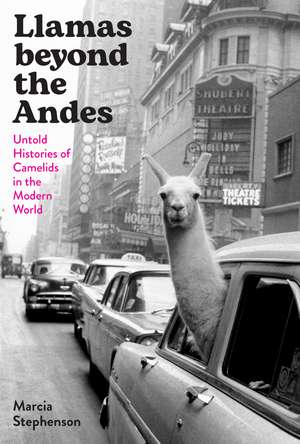Llamas beyond the Andes: Untold Histories of Camelids in the Modern World
Autor Marcia Stephensonen Limba Engleză Hardback – 12 dec 2023
Initially Europeans prized camelids for the bezoar stones found in their guts: boluses of ingested matter that were thought to have curative powers. Then the animals themselves were shipped abroad as exotica. As Europeans and US Americans came to recognize the economic value of camelids, new questions emerged: What would these novel sources of protein and fiber mean for the sheep industry? And how best to cultivate herds? Andeans had the expertise, but knowledge sharing was rarely easy. Marcia Stephenson explores the myriad scientific, commercial, and cultural interests that have attended camelids globally, making these animals a critical meeting point for diverse groups from the North and South.
Preț: 337.47 lei
Nou
Puncte Express: 506
Preț estimativ în valută:
64.58€ • 67.73$ • 53.76£
64.58€ • 67.73$ • 53.76£
Carte nepublicată încă
Doresc să fiu notificat când acest titlu va fi disponibil:
Se trimite...
Preluare comenzi: 021 569.72.76
Specificații
ISBN-13: 9781477328408
ISBN-10: 1477328408
Pagini: 448
Ilustrații: 23 b&w illustrations, 11 b&w photos, 1 map
Dimensiuni: 152 x 229 x 41 mm
Greutate: 0.77 kg
Editura: University of Texas Press
Colecția University of Texas Press
ISBN-10: 1477328408
Pagini: 448
Ilustrații: 23 b&w illustrations, 11 b&w photos, 1 map
Dimensiuni: 152 x 229 x 41 mm
Greutate: 0.77 kg
Editura: University of Texas Press
Colecția University of Texas Press
Notă biografică
Marcia Stephenson is an associate professor of Spanish at Purdue University. Her book Gender and Modernity in Andean Bolivia received the A. B. Thomas Award for Excellence.
Cuprins
- List of Abbreviations
- Introduction. “The Most Interesting Animals in the World”: Reconstructing Histories of Andean Camelids in Transoceanic Contact Zones
- Chapter 1. From Marvelous Antidote to the Poison of Idolatry: The Transatlantic Significance of Andean Bezoar Stones during the Late Sixteenth and Early Seventeenth Centuries
- Chapter 2. Exploring the Body-Interior: Autopsy in Colonial Camelid Contact Zones
- Chapter 3. From Curiosity to Commodity: Early Efforts to Ship Living Camelids to Europe
- Chapter 4. The Science of Acclimatization: Llamas and Alpacas in Nineteenth-Century France
- Chapter 5. Andean Itineraries of Nineteenth-Century Camelid Science: The Case of Charles Ledger
- Chapter 6. Camelids in Australia: The Rise and Fall of Charles Ledger’s Alpaca Ambitions
- Chapter 7. US Camelid Contact Zones in the Twentieth Century: Authenticity, Exoticism, and Celebrity
- Conclusion. The Afterlives of Camelid Contact Zones
- Acknowledgments
- Notes
- Works Cited
- Index
Recenzii
This is a highly scholarly work, recommended for academic libraries with graduate programs in Latin American studies.
By searching the documentation for evidence of the bonds that camelids and humans may have developed, and by trying to understand a llama’s needs through ethological observations of their behaviors, we can write something about their experiences as inhabitants of Earth. For a brief moment, Llinda Llee Llama experienced the strangeness of an automobile ride in New York City. She had a unique history, which Marcia Stephenson records. She is now remembered, after being used and discarded as a cultural contact zone.
A milestone for many historiographies, a mandatory stop for many classrooms, and a must-read for everyone interested in understanding the llama.
Stephenson delivers an original and compelling account of how the Andes has actively shaped Western science, aesthetics, and commerce...supported by illuminating conceptual interventions that [force] us to expand and subvert common approaches to Western imperial history.
This is an elegant and attractive narrative built upon an impressive array of primary historical sources.
Stephenson’s study is a welcome addition to historical studies of human-animal relations and the generation of knowledge in colonial situations.It is valuable in uncovering forgotten histories unfolding in different configurations of power. It also acts as a reminder of the toll that efforts at exporting live animals took in terms of animal lives and the damage caused to Indigenous livelihoods.
Descriere
An exploration of the unexpected role that llamas and other Andean camelids played in transoceanic relationships and knowledge exchange.
